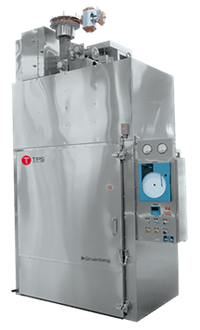Safety Oven Design Considerations for NFPA Requirements
Industrial ovens are used for processes that require the application of heat to a material. Some of these processes involve the heating of volatile or flammable solvents. For hazardous material processing, a safety oven, which includes class A ovens and explosion-proof ovens, is required to reduce the risk of a fire or explosion. These ovens are designed to address one of the three ignition sources in volatile applications: oxygen, heat, or fuel.
Safety oven designs vary greatly in the technology used, complexity, initial cost, and ongoing operating and maintenance costs. Designs are also heavily dependent on industry standards in relation to hazardous material processing. For example, NFPA 86 and NFPA 70 standards and requirements are critical factors of safety oven design.
NFPA Oven Requirements
Industry standards that require compliance with specifications such as NFPA 86 or NFPA 70 are another key consideration in the design of your safety oven. These industry codes specify requirements for items such as Lower Flammability Limit (LFL), Limiting Oxidant Concentration (LOC), monitoring equipment, air flow, and approved heat sources. Typical safety oven classifications are:
What is a Class A Oven?
Class A safety oven designs comply with NFPA 86 requirements. These designs utilize mechanical ventilation to dilute flammable vapors to a level that is too low to ignite. To do this the process begins with a purge cycle that runs four volumes of fresh air through the system before the heat source is enabled.
Key specifications for a Class A oven are:
- Dilution air flow rate that keeps vapor concentration from exceeding 25% of the LFL
- Systems with a solvent monitor are permitted to operate at up to 50% of the LFL
- Explosion venting is required
Class A oven designs provide the advantages of simplicity in design, low initial cost, and are low maintenance. The drawback to the Class A oven design is when processing large solvent loads, the air flow make-up requirement will be high which can lead to high operating costs from the continual heating of cold intake air.
Low Oxygen Class A
Class A ovens can also be designed as low oxygen which limits the Limiting Oxidant Concentration (LOC) instead of the LFL. Low Oxygen Class A oven designs also comply with NFPA 86 by using an inert atmosphere to remove atmospheric oxygen from the process which would cause combustion. Inert gas creates an atmosphere that decreases the oxygen concentration to a level that is no longer flammable, known as the LOC.
Key specifications for a Low Oxygen Class A Oven are:
- Oxygen analyzer for initial purge cycle to verifies oxygen concentration is at least 3% below the LOC before allowing the heaters to be energized
- Oxygen concentration at least 3% below the LOC is maintained for the duration of the cycle
- If the oxygen concentration raises above the LOC, the system is required to de-energize the heat source and abort the cycle
The advantages of a Low Oxygen Class A oven include the high degree of safety, the ability to process an unlimited quantity of solvent and the low process gas flow rate. The low flow rate makes solvent recovery an attractive option for these ovens. Another advantage is that explosion relief is not required on Low Oxygen ovens. Disadvantages include the higher initial equipment cost and the ongoing cost of inert gas.
Explosion Proof
NFPA 70, the National Electrical Code (NEC), specifies requirements for Explosion Proof (XP) Oven designs. The design of the oven itself is not meant to withstand an internal explosion, rather the explosion proof designation requires the elimination of all sources of ignition. NEC requires that electrical equipment installed in “Hazardous (Classified) Locations” is designed with the following specifications:
- Exposed electrical components such as motors, switches, junction boxes, and conduit must be XP rated
- Control boxes are XP rated or purged and pressurized
- XP enclosures: Designed to withstand the full pressure of an internal explosion
- Purged and pressurized enclosures: Standard control cabinets with a control system that supplies a protective gas to the cabinet. Prior to the cabinet being energized, four volumes of purge gas are circulated through the cabinet and slight pressure is maintained. If at any time the pressure is lost, the system is automatically de-energized.
- Intrinsic barriers are placed between the sensors and the controls that read them to limit available energy to a level too low to cause an ignition
- Per ANSI/AMCA standard 99-16, fans or blowers must be of spark resistant construction
- The surface temperature of all exposed components cannot exceed the established Temperature Class (T-Code) for the classified location. If no T-Code is specified, a limit of 80% of the auto-ignition temperature of the flammable material must be maintained.
Gruenberg is a leading supplier of safety ovens for hazardous material processing. Our experienced team thoroughly reviews your process and industry requirements to ensure that the optimal design is used for your safety oven. Learn more about Gruenberg safety ovens.




